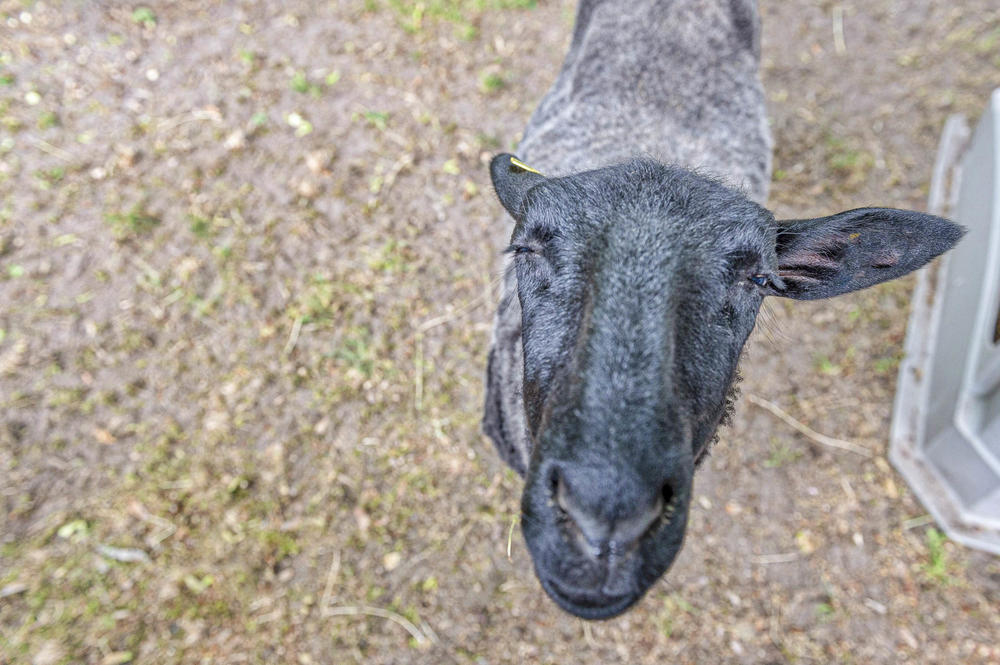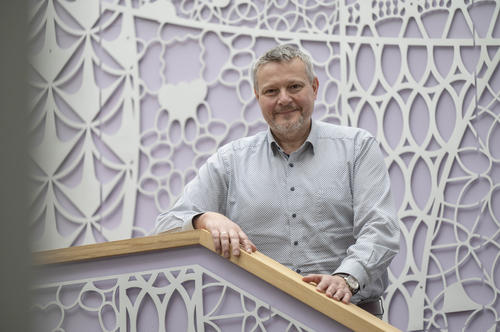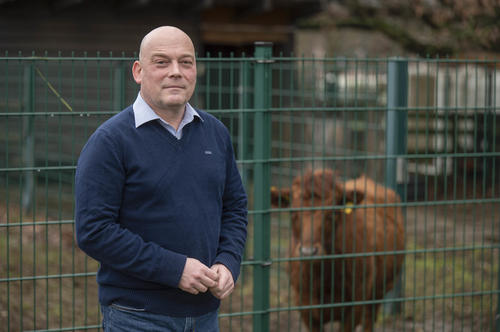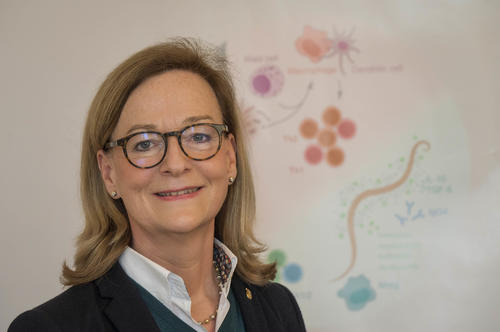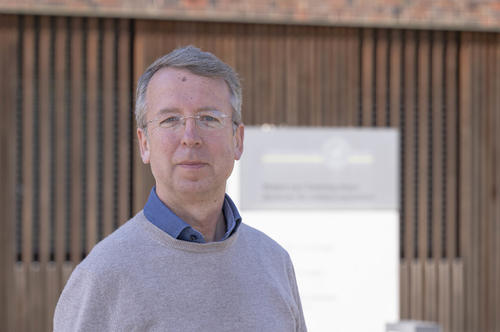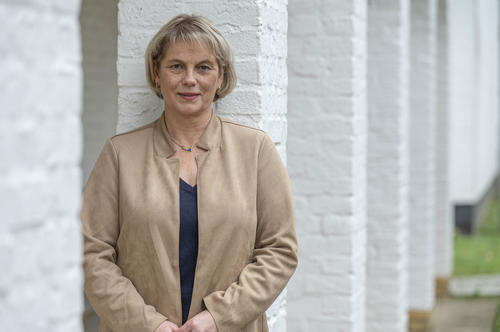Veterinary diversity in Berlin
The veterinarians at Freie Universität conduct research on zoonoses and our food safety, they analyze resistant pathogens and study worm diseases in the global South.
Feb 23, 2023
In addition, they develop methods to reduce animal testing and train the veterinarians of tomorrow. Together, they have one goal: to improve human, animal and environmental health.
Veterinary Medicine at Freie Universität takes care of many kinds of animals - including sheep.
Image Credit: Bernd Wannenmacher
When people talk about veterinary medicine in Berlin, the first thing that comes to mind is the Small Animal and Pet Clinic of Freie Universität in Düppel. Every year, about 8,000 animals are examined, treated, cared for, and often rescued here. "For pet owners in Berlin, our small animal clinic is naturally of the greatest importance," says Dr. Uwe Rösler, Professor of Animal Hygiene and Infectiology and Dean of the Department of Veterinary Medicine at Freie Universität. "There are only five veterinary medical training institutions in Germany, and Freie Universität is the only one in a city-state. That's the reason for its special profile, and that brings special challenges."
Veterinary medicine is needed everywhere
Clinical care and research are focal points of his department, Rösler explains, and also for animal species that are rarely seen in the Berlin cityscape: Horses, cattle and other so-called hoofed animals such as sheep and goats, pigs, and also poultry. For this purpose, Freie Universität operates three veterinary clinics in Berlin's southwest, in Düppel. But Berlin veterinarians work not only in the veterinary clinics and in research and teaching at the institutes of the Department of Veterinary Medicine, but also in the city's veterinary practices, the veterinary offices in food monitoring and animal welfare, and in many federal agencies based in the capital. In Berlin, of course, the distribution looks different than in Schleswig-Holstein, for example: in the capital, about one-third of veterinarians work in a small animal practice or clinic, one-third in the office and one-third in research.
In the future, the importance of veterinarians in research will increase. The state of our planet, the emergence of new zoonoses - diseases that can be transmitted from animals to humans, such as Covid-19, and the increase in resistant pathogens make it abundantly clear: those who care about human health must also care about animal health.
Dr. Uwe Rösler, Professor of Animal Hygiene and Infectiology and Dean of the Department of Veterinary Medicine: "We are interested in how farm animals become infected with diseases."
Image Credit: Bernd Wannenmacher
"One Health" is the buzzword, i.e. the idea that the health of humans, animals and the environment is closely linked and interdependent. Of course, veterinary research topics were already permeated by this idea when "One Health" did not even exist: for example, at the Institute for Animal and Environmental Hygiene in the Department of Veterinary Medicine, which Rösler heads. He explains: "We are interested in how farm animals become infected with diseases. Important here are the ways pathogens spread: from animal to animal, from human to animal, from shovel handle to animal, through drinking water, with bedding, in manure, in wastewater, via the wind, on pasture, from the environment into the barn and vice versa."
Veterinary medicine under one roof
To compare different husbandry conditions, Rösler and his colleagues at the department had to visit farms throughout Germany until recently. Since April 2022, they have been able to realistically and practically simulate almost all environmental and husbandry factors at Freie Universität's new Veterinary Center for Resistance Research (TZR): from the size of animal groups to flooring to fresh air supply. This equipment, which is unique in Europe, makes it possible, for example, to research under which husbandry conditions farm animals are more resistant to infectious agents. In the future, this could make it possible to administer fewer antibiotics. This is important because more and more bacteria are now resistant to the active substances available. "But the drugs themselves also spread in the environment," says Rösler. "From each tablet, a large proportion of the active ingredients end up back in the environment via excretion; and if we're unlucky, in our food and drinking water. Or this leads to the development of resistance in environmental germs."
In order to research the complicated substance cycles and physiological processes in humans and animals, it is necessary for experts from a wide variety of disciplines in the field of veterinary medicine, as well as from human and environmental medicine, to work together. This is done in the TZR, in the clinics and in the Robert von Ostertag House, which was opened back in 2014 and houses five institutes. However, especially when it comes to ensuring the safety of food, researchers also often work in consortia with partners from agriculture or industry. The work of Prof. Dr. Thomas Alter is one example of this.
Dr. Thomas Alter conducts research on food safety and hygiene as a professor and heads the institute of the same name in the Department of Veterinary Medicine.
Image Credit: Bernd Wannenmacher
Germs in meat
Today, many people pay attention to healthy eating. Dr. Thomas Alter is working to ensure that food at least doesn't make us sick. He is a professor of food safety and hygiene and heads the institute of the same name in the Department of Veterinary Medicine. "I'm often asked why veterinarians are responsible for food safety," Alter says. That's because his research doesn't begin until after the animal has died, when it has been slaughtered and its meat has become a product. "Our responsibility for this topic started 150 years ago in Berlin," Alter explains. At that time, the physician Robert Koch was conducting research here on zoonoses such as bovine tuberculosis, which was transmitted through raw milk. And a few meters away, very close to him, the veterinarian Robert von Ostertag was working on the first regulations for meat inspection at Prussian slaughterhouses. Veterinarians ensured that fewer people became ill from animal diseases, so they were service providers for human medicine. "In principle, we still are today," Alter says. "Close collaborations are very important for us, for example with Charité."
The diseases Koch and von Ostertag were concerned about can now be treated. Instead of tuberculosis and anthrax, for example, bacteria of the Campylobacter genus now make headlines, especially before Christmas and New Year's Eve, when many people cook chicken meat too briefly in the fondue pot or on the raclette grill. About 40 percent of broilers in the European Union carry Campylobacter in their intestines. The animals themselves do not get sick, but the pathogens can get onto the meat during slaughter. Every year, about 70,000 people in Germany are affected, and campylobacteriosis is the most common zoonosis in the EU. It causes fever and diarrhea, but can also lead to severe complications, such as Guillain-Barré syndrome with muscle weakness and paralysis. The link between the pathogen and the disease has been known for several years thanks to improved diagnostics. Since 2018, infections with Campylobacter bacteria have been reportable - and are at the top of Alters' research agenda.
Marinating, chlorinating, freezing, cooking.
"Unlike Salmonella, we can't vaccinate chickens against Campylobacter," he explains. "So we have to start at different points in the so-called food chain. Slaughter and processing fall within my scope of work, but so does consumer education." He says there are various ways to ensure that no contaminated meat enters the market, for example by using a bacteriograph, marinating, chlorinating, freezing, cooking, or UV light. Some things politicians don't want, some things consumers don't want - and some things would be unprofitable for the companies. Alter is therefore researching what might work in collaboration with the food industry. "We have never had any bad experiences with this. After all, the people in charge don't want to make anyone sick."
In addition, his research benefits from Berlin as a location: "The distances are short: to the Charité, to the non-university research institutions, for example to the "Federal Institute for Risk Assessment" and to the ministries. People know each other - and such 'soft' factors make the work much easier."
Dr. Susanne Hartmann is Professor of Infection Immunology and Director of the Institute of Immunology; one of her specialties: the porcine roundworm.
Image Credit: Bernd Wannenmacher
Worms in our bodies
Unlike Campylobacter bacteria, whose importance was only recognized a few decades ago, or coronaviruses, which are constantly emerging, parasitic worms have lived in our bodies since the dawn of mankind. Dr. Susanne Hartmann, Professor of Infectious Immunology and Director of the Institute of Immunology says: "Worms have undergone co-evolution with us over millions of years. That's why they can manipulate our immune system and probably even our microbiome, the totality of microorganisms living in us, so perfectly that they survive for many years even in people with strong defenses."
The human body is a habitat for worms. That's why worm infections are less deadly; instead, they trigger diseases that weaken the body over time. Hartmann is researching how worms manage to exploit our immune system for their own benefit and how they interact with pathogens in the process. The pig roundworm is an ideal research object for her, because it attacks both pigs and humans. It is therefore possible to observe in the animal how the worm and the host's immune system interact - and to draw insights from this that can help many people worldwide.
20 centimeters long, as thick as a little finger: the pig roundworm
Compared to bacteria or viruses, pig roundworms are huge: they grow up to 20 centimeters long and are as thick as a little finger. Worms in animals are also present in our latitudes, and there is no risk of infection for humans due to the high standards of hygiene. In the Global South, however, the worm is a scourge for humans. Hartmann conducts research in Africa, among other places, where she studies schoolchildren infected by roundworm. She says, "The children sit on the bare earth at school, many walk barefoot, there are insufficient toilet pits and very often no way to wash their hands." In addition, when fields and gardens are fertilized with feces, worm infection is often the result. The worm eggs develop in the soil, on fruits and vegetables.
The consequences are dramatic. Many of the children in the Global South are malnourished. If worms live in their intestines, they also eat away nutrients. "The children suffer from iron deficiency and protein deficiency, many are malnourished," reports Hartmann: "They feel listless, have stomach and intestinal complaints. And if they can't go to school or concentrate properly there because of the worm infection, it also stunts their mental development." The World Health Organization (WHO) measures the impact in "disability-adjusted life years," or the number of healthy life years lost to these children and, ultimately, to societies in the Global South "You can only fight these infections with the global health approach," Hartmann says, "in cooperation between infectiologists, social, environmental, nutritional and health systems sciences." The WHO has declared war on worm infection as a "neglected tropical disease." But worldwide, there are only a handful of experts studying the myriad worm species and their complex effects on humans, animals and the environment.
Research in cooperation
The Department of Veterinary Medicine is therefore particularly proud of the Research Training Group "Parasite Infections: from Experimental Models to Natural Systems," of which Hartmann has been the spokesperson since 2015. The college, which is funded by the German Research Foundation, combines the expertise of researchers at Freie Universität with that of Humboldt-Universität, Charité, the Robert Koch Institute, the Max Planck Institute for Infection Biology, and the Max Planck Institute of Colloids and Interfaces, as well as the Leibniz Institute for Zoo and Wildlife Research. "By 2024, we will train 60 doctoral students in molecular, immunological and wildlife aspects of parasite infections, which is a considerable strengthening of the worldwide research network on parasite infections. Berlin has a unique selling point in this field."
The affected countries are tackling the parasites with major deworming campaigns. However, this could make the problem even bigger in the future, Hartmann explains: "People keep getting re-infected due to insufficient sanitation and thus contaminated soil. Permanent reinfections, however, lead to the parasites eventually becoming resistant to the current deworming agents."
Prof. Dr. Georg von Samson-Himmelstjerna heads the Institute of Parasitology and Tropical Veterinary Medicine in the Department of Veterinary Medicine and is spokesman for the new Veterinary Center for Resistance Research.
Image Credit: Bernd Wannenmacher
Evolutionary patterns for resistance
So far, the success of deworming campaigns has been reviewed too rarely, says Prof. Dr. Georg von Samson-Himmelstjerna. He heads the Institute of Parasitology and Tropical Veterinary Medicine in the Department of Veterinary Medicine and is spokesman for the TZR. He also regularly conducts studies in Africa. If he finds people or animals in which the worming agents no longer work, he takes samples back to Berlin. There, he tries to propagate the resistant worms: a difficult subject, because worms, unlike bacteria, cannot be bred in the Petri dish; they need a host. So you have to infect animals. Even if "organs on a chip" were eventually developed that could simulate worm infestation of livers or lungs, the complex interplay of the immune system or the migration of parasites through different organs can only be studied in living organisms. The variable housing conditions in the TZR offer the ideal conditions for this.
By comparing different worm strains, von Samson-Himmelstjerna and his team are trying to find out which mutations have helped the worms to become resistant: an important step in the race against resistant pathogens. Not only worms, but also bacteria, fungi and viruses have found loopholes to evade drugs and vaccines. And as different as the pathogens are, it is at least not unlikely that the loopholes are similar. The TZR offers conditions for this research that are unique in Europe, perhaps even the world, says von Samson-Himmelstjerna: "The center has already developed a clear momentum of its own after just under a year. It spurs exchange between disciplines, for example with biology, chemistry and pharmacy or with agricultural sciences." Despite the veterinary perspective, the researchers always keep humans and the environment in mind. Von Samson-Himmelstjerna explains, "Infectious medicine disciplines are involved in all TZR projects, often also basic research disciplines. Equally important is the involvement of clinical research through the veterinary clinics of Freie Universität or for human medicine, for example, through the cooperation with Charité."
Prof. Dr. Christa Thöne-Reineke is head of the Institute for Animal Welfare, Animal Behavior and Laboratory Animal Science at the Department of Veterinary Medicine and also represents these subjects in research and teaching.
Animal welfare in research
The German Animal Welfare Act defines animal experiments as interventions or treatments for experimental purposes that may involve pain, suffering or harm. Last year, the law was tightened again, so that any use of animals in the context of training now also counts as animal experimentation. This means that training veterinary students on animals is an animal experiment if this is only done for educational purposes at the university. This is in contrast to procedures that are performed based on a veterinary diagnosis.
Animal experiments may only be carried out if they have been approved by the relevant authorities. The application form alone is twelve pages long. In the application, ethical justifiability must be stated, i.e. the expected gain in knowledge must be weighed against the burdens. In addition, it must be explained why these findings cannot be obtained using alternative methods, how it can be ensured that as few animals as possible are used, and how their stress can be kept as low as possible. The last three points are usually summarized with the English terms replacement (reduce), reduction (reduce) and refinement (refine) to the abbreviation "3R".
Berlin as the capital of alternative methods
Prof. Dr. Christa Thöne-Reineke, who heads the Institute of Animal Welfare, Behavior and Laboratory Animal Science at the Department of Veterinary Medicine and represents the subjects in research and teaching, looks back with pride on what has been achieved in recent years: "In 2014, at the end of my inaugural lecture, I formulated the wish that Berlin would become the capital of the 3Rs. I did not dare to dream that we are now even one step further: Berlin is the capital of the 3Rs and should now become the capital of alternative methods." He said that Freie Universität has always led the way, for example with the graduate school of the Berlin-Brandenburg research platform BB3R, which bundles research in this field and qualifies young scientists in alternative methods and animal-friendly working methods. Later, the Charité joined with its 3R program, and since summer 2020 Thöne-Reineke has represented Freie Universität as deputy spokesperson in the newly founded Einstein Center 3R.
The animal welfare officer says it is important to develop alternative methods. However, false expectations should not be raised: In some areas, she says, we will still be dependent on animal experiments for a very long time, for example in behavioral research, in immune research, and in the development of new drugs and vaccines. "In the final analysis, we have to ask ourselves: can we justify banning animal experiments in our country if they are then carried out in other countries, possibly without controls and qualified personnel?"
Sometimes it is obvious that an animal is suffering, but often it is not. As a behavioral scientist, Thöne-Reineke and an interdisciplinary team in the Science of Intelligence (SCIoI) cluster of excellence, which is funded by the German Research Foundation, are developing supported methods with which so-called animal welfare indicators can be recorded and improved, also thanks to artificial intelligence, for example to recognize when mice are stressed by their facial expressions. Her colleagues are investigating a similar approach with farm animals and horses. "In the "HorseWatch" project, funded by the German Federal Ministry of Education and Research, we want to use behavioral studies to find out at what age warm-blooded, galloping and trotting horses should be trained so that they suffer as little as possible." Because it's not just laboratory animals that experience stress, Thöne-Reineke says: "I'd like to see the ethical questions we ask ourselves in research applied to the way we treat pets and farm animals."
In any case, animal welfare and animal protection do not hinder scientific knowledge; on the contrary, says Thöne-Reineke: "I can only get valid and reproducible results from an animal that is treated well and feels comfortable. She has been bringing this connection home to colleagues in other disciplines for years. "In all teams that conduct animal experiments, at least one veterinarian should make sure that the animals are well. Otherwise, the most modern measurement methods are useless."
This, of course, requires that animal ethics and animal experimentation science be offered in veterinary medical education, as is the case at Freie Universität. Thöne-Reineke, together with pharmacology professor Dr. Schäfer-Korting and pharmacologist Dr. Vivian Krahl, was awarded the 2015 Research Prize of the State of Berlin for their lecture series "Alternatives to Animal Testing in Research, Education, and Teaching." Long before Corona, interested parties had also been able to follow this lecture series online, she says: "And every year we have more participants. At the moment, there are 2,000 people from all over the world. This success surprises me myself."
The special Berlin "spirit
In the exchange with students, many ideas for improvements and further developments emerge, says Thöne-Reineke: a code of ethics by students for students of veterinary medicine, for example; or animal models on which study content can be taught and practiced without using live animals. Dean Rösler also praises the students' commitment and empathy: "They demand that we research and develop modern, sustainable husbandry systems for agriculture that are oriented toward animal welfare. And they encourage us to give appropriate impulses to politics and society." Thomas Alter perceives a special Berlin "spirit": "The interest of our students is shifting: away from meat and toward the food of the future." For example, he says, seminars on the food safety of fish and shellfish are in high demand. However, there has hardly been any research on other trendy topics such as insects or cell cultured meat at German universities. Who knows: Perhaps the students at Freie Universität are developing ideas that will make Berlin a research pioneer in this field as well.

